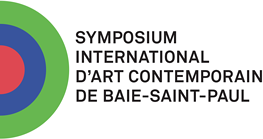July 26–August 25, 2019
23, rue Ambroise-Fafard
Baie-Saint-Paul Québec G3Z 2J2
Canada
Hours: Monday–Sunday 11am–5pm
T +1 418 435 3681
F +1 418 435 6269
info@macbsp.com
For the 37th edition, the ISCABSP is proposing the theme of Art, Architecture and Environment, a subject that occurs quite naturally in the wake of the issues broached in the previous edition of Art and Politics. It is important to have Ariadne’s thread weave a continuation of ideas, which will link the editions of the same artistic direction. Already, at the beginning of my mandate in 2017, I had the feeling that issues of Art, Architecture, Landscape and Environment would emerge. The main idea is to give the artists an opportunity to appropriate the new Symposium building, with the first objective being to create in situ works both inside and outside the École walls. This would be a gesture, an artistic, political and social impetus for some kind of collective creation in the Baie-Saint-Paul community itself.
Of course, this is not the first time that artists will take over public space with site-specific works but having a collective goal while respecting the individual work of each artist will represent, in my view, a new challenge and a most stimulating adventure. An undertaking that moves away from the commissions of the “art-architecture complex,”[1] closely linked to our evolving capitalist society. Art, Architecture, Landscape and Environment can undeniably illustrate the representation of power, according to the sponsors’ recommended contexts.
For the ISCABSP 2019 edition, post-G7, it would be inspiring to go against the current of public art policies in use now and make them “unofficial.” Following the example of Gordon Matta-Clark’s work carried out in the 1970s, which was always conceived of on the razor’s edge between art and architecture, which artist designated as anarchitecture, and was developed from a socio-historical reflection on these two forms, often creating tension between one and the other. One might imagine a process that includes an investigation about the local, regional and tourist populations, that could enrich the artists’ reflections. But this “methodology” must not in any way prevent the artists from having carte blanche in their conception and production of this ambitious program and its outcome.
All visual art and media art disciplines are welcome. Here are some subjects, among others, that could be combined for the project:
Is Architecture, as one of the first two arts with music, still compatible with the visual arts, in projects to integrate art into architecture, such as was hoped for, in nearly the last 60 years?
Working with architects, landscape designers and environmental specialists, to succeed in truly integrating a project, prior to the establishment of the architectural program for a building or for the landscaping design.
Inventing a new model for bringing together art, architecture and environment.
These three areas of activity understood as a call to construct a peaceful world, in rebuilding cities that armed conflicts and natural disasters have destroyed. To conceive of “intelligent” and qualitative cities for all levels of society.
Some architects have designed model refugee camps in which life is less difficult than in those where access to decent hygiene, drinking water and privacy is limited, even impossible. Is it possible to think about such temporary places where people would not feel excluded from society?
Could the “landscape,” understood in its Euclidian and broadest sense since the Italian Renaissance, be transformed into something more open, more inclusive (think digital but not exclusively)?
Are collaborations between people in the arts, architecture, the environment and sustainable development, as well as the community’s contributions, purely utopic or unattainable visions? Or could we make them happen?
Sylvie Lacerte, PhD
Artistic Director, ISCABSP
[1] Hal Foster, The Art and Architecture Complex, 2011.



